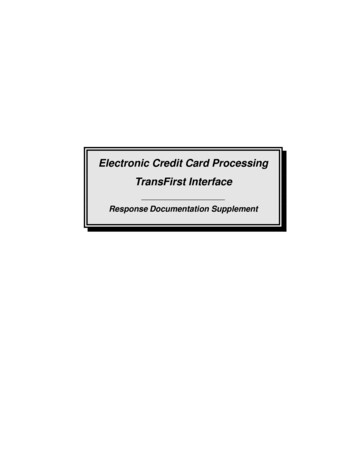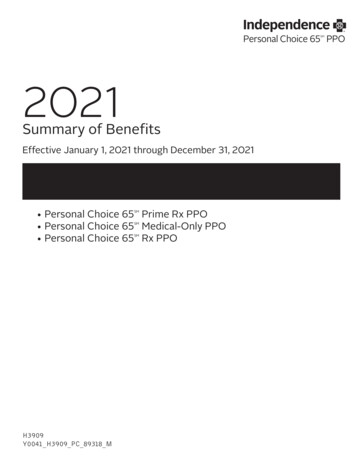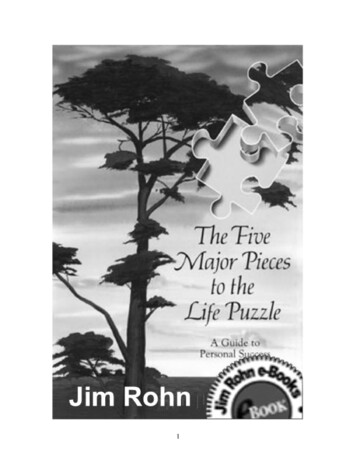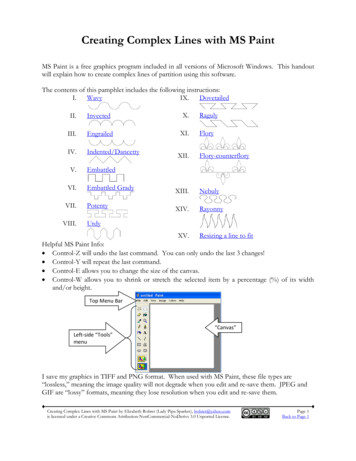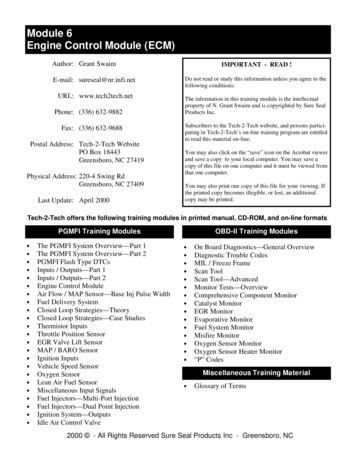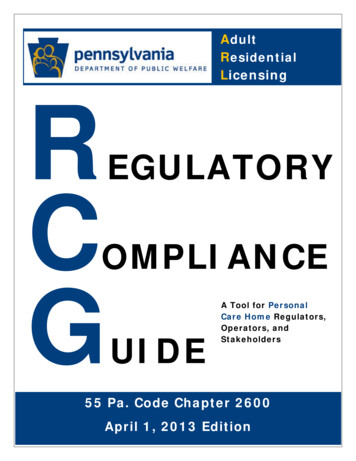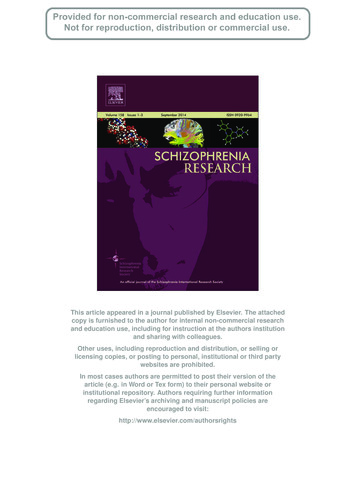
Transcription
This article appeared in a journal published by Elsevier. The attachedcopy is furnished to the author for internal non-commercial researchand education use, including for instruction at the authors institutionand sharing with colleagues.Other uses, including reproduction and distribution, or selling orlicensing copies, or posting to personal, institutional or third partywebsites are prohibited.In most cases authors are permitted to post their version of thearticle (e.g. in Word or Tex form) to their personal website orinstitutional repository. Authors requiring further informationregarding Elsevier’s archiving and manuscript policies areencouraged to visit:http://www.elsevier.com/authorsrights
Author's personal copySchizophrenia Research 158 (2014) 204–212Contents lists available at ScienceDirectSchizophrenia Researchjournal homepage: www.elsevier.com/locate/schresThe functional anatomy of schizophrenia: A dynamic causal modelingstudy of predictive codingNoa Fogelson a,⁎, Vladimir Litvak b, Avi Peled c,d, Miguel Fernandez-del-Olmo e, Karl Friston b,⁎⁎aJoseph Sagol Neuroscience Center, Sheba Medical Center, Tel Hashomer, IsraelThe Wellcome Trust Centre for Neuroimaging, Institute of Neurology, UCL, London, UKInstitute for Psychiatric Studies, Sha'ar Menashe Mental Health Center, Hadera, IsraeldB Rappaport Faculty of Medicine, Technion, Haifa, IsraeleDepartment of Physical Education, University of A Coruña, La Coruña, Spainbca r t i c l ei n f oArticle history:Received 5 December 2013Received in revised form 8 May 2014Accepted 1 June 2014Available online 3 July 2014Keywords:Dynamic causal modelingSchizophreniaEEGPredictionConnectivitya b s t r a c tThis paper tests the hypothesis that patients with schizophrenia have a deficit in selectively attending topredictable events. We used dynamic causal modeling (DCM) of electrophysiological responses – to predictableand unpredictable visual targets – to quantify the effective connectivity within and between cortical sources inthe visual hierarchy in 25 schizophrenia patients and 25 age-matched controls. We found evidence for markeddifferences between normal subjects and schizophrenia patients in the strength of extrinsic backward connections from higher hierarchical levels to lower levels within the visual system. In addition, we show thatnot only do schizophrenia subjects have abnormal connectivity but also that they fail to adjust or optimizethis connectivity when events can be predicted. Thus, the differential intrinsic recurrent connectivityobserved during processing of predictable versus unpredictable targets was markedly attenuated in schizophrenia patients compared with controls, suggesting a failure to modulate the sensitivity of neuronsresponsible for passing sensory information of prediction errors up the visual cortical hierarchy. The findings support the proposed role of abnormal connectivity in the neuropathology and pathophysiology ofschizophrenia. 2014 The Authors. Published by Elsevier B.V. This is an open access article under the CC BY-NC-ND nd/3.0/).1. IntroductionIn a previous study we found consistent and large deficits in differential responses to predicted and unpredicted targets, using event related responses – as measured with EEG – in schizophrenia patients. Inhealthy adults predicted targets produced faster reaction times andshorter event-related potential (ERP) P3b latencies compared with targets after non-predictive sequences. Crucially, this context-dependentfacilitation was attenuated in patients with schizophrenia (Fogelsonet al., 2011).In the current study, we revisit these differences in terms of the underlying functional and computational anatomy. We used the same datato estimate the effective connectivity or directed coupling within andamong cortical sources — and differences in this coupling when stimuli⁎ Correspondence to: N. Fogelson, The Joseph Sagol Neuroscience Center, Sheba MedicalCenter, Tel Hashomer, Ramat Gan 52621, Israel. Tel.: 972 35304753; fax: 972 35304752.⁎⁎ Correspondence to: K. Friston, The Wellcome Trust Centre for Neuroimaging, Instituteof Neurology, UCL, 12 Queen Square, London WC1N 3BG, UK. Fax: 44 207 813 1445.E-mail addresses: nfogelson@gmail.com (N. Fogelson), k.friston@ucl.ac.uk (K. Friston).are predictable. Connectivity was evaluated using dynamic causalmodeling (DCM), where non-linear dynamic neuronal interactions between different regions are estimated (Friston et al., 2003). Theparticular hypothesis addressed by the current DCM study was thatthe excitability of superficial pyramidal cells differs between normaland schizophrenia subjects (i.e., excitability shows a main effect ofgroup) and that predictability effects on this excitability would beattenuated in schizophrenia (i.e., excitability shows a group by condition interaction). Hierarchical Bayesian inference or predictive codingwas used to test this hypothesis. In predictive coding top-down predictions (conditional expectations) are generated and compared withbottom-up sensory inputs to produce prediction errors. Prediction errors that are weighted in proportion to their expected precision areused to update higher level expectations, which in turn reduce lowerlevel prediction errors (Friston, 2008; Bastos et al., 2012). Thus, optimization of high-level predictions ensures an accurate prediction ofsensory input.Hierarchical Bayesian inference and predictive coding have beenlinked to schizophrenia and psychosis, so that precision correspondsto the confidence or certainty associated with a belief, and inappropriatebeliefs about precision can lead to false inference (Adams et al., 110920-9964/ 2014 The Authors. Published by Elsevier B.V. This is an open access article under the CC BY-NC-ND license ).
Author's personal copyN. Fogelson et al. / Schizophrenia Research 158 (2014) 204–212The suggestion is that psychotic symptoms can be explained interms of a failure to represent precision regarding beliefs aboutthe world (Adams et al., 2012, 2013), which corresponds to currentthinking about the neuropathology of schizophrenia implicating theneuromodulation of postsynaptic excitability or cortical gain control;particularly in the supragranular cortical lamina (Harrison et al.,2011). This reflects the fact that many of the neurotransmitter receptorsimplicated in schizophrenia are expressed most densely in superficiallayers (for example, dopamine — D1-R and NMDA-R) and are involvedin the modulation of postsynaptic excitability or gain (Cohen andServan-Schreiber, 1992; Friston and Frith, 1995; Friston, 1998; Wang,2002; Coyle and Tsai, 2004; Stephan et al., 2006).This is important from the point of view of predictive codingmodels of inference in the brain, because superficial pyramidal cellsare thought to encode prediction error (Friston, 2008; Bastos et al.,2012). Superficial pyramidal cells convey prediction errors via extrinsic forward ascending connections (targeting spiny stellatecells), while deep pyramidal cells are thought to convey predictions,via extrinsic backward descending connections that target superficial pyramidal cells (Mumford, 1992; Friston, 2008; Bastos et al.,2012). In addition to the reciprocal exchange of signals through forward and backward extrinsic connectivity, the relative influence ofprediction errors on higher-level expectations is itself optimizedin terms of their relative weight and gain. This is thought to beimplemented by intrinsic connectivity that controls the gain of neuronal populations broadcasting prediction errors (Friston, 2008;Bastos et al., 2012). The resulting excitability of superficial pyramidalcells corresponds (mathematically) to the precision of – or confidence in – the information conveyed by ascending prediction errors,that are weighted in proportion to their expected precision (Friston,2008; Bastos et al., 2012). Precision is thought to be encoded by thepost-synaptic gain of neurons that report prediction errors and hasbeen used to explain both the psychophysical and electrophysiological correlates of attention, so that sensory processing channels thatconvey precise information are selectively enabled by an increasein their precision (Friston, 2008; Feldman and Friston, 2010; Bastoset al., 2012). Cortical bias or gain control is mediated by intrinsicinhibitory connections within cortical sources, which rescale prediction errors, in proportion to their precision, so that as precision increases intrinsic recurrent inhibition decreases (Abbott et al., 1997;Friston, 2008). Heuristically, precision can be thought of as a ‘volumecontrol’ that is applied to prediction errors that are broadcast torevise predictions elsewhere in the hierarchy. In summary, optimization of high-level predictions reduces prediction error at lower levels,ensuring an accurate prediction of sensory input.Currently, predictive coding schemes do not differentiate betweenthe encoding associated with single cells and neuronal populations. Inother words, predictions and prediction errors may be encoded by thefiring rate averaged over populations of (superficial or deep pyramidal)cells. In our modeling, we assume that fluctuations in firing ratescorrespond to the ensemble averages implicit in neural mass modelsof cortical activity.In neurobiological formulations of predictive coding (Mumford,1992; Friston, 2005; Friston et al., 2005; Bastos et al., 2012), superficial pyramidal cells are thought to report precision-weightedprediction error: ξ Π(μi g(μi 1)), where μi corresponds to representations (posterior expectations) of states of the world at level iin a cortical hierarchy and g(μi 1) corresponds to the top-down predictions of these expectations — based upon expectations in the levelabove. The precision of the ensuing prediction error – or mismatch –is modulated by the precision Π to weight the prediction errors in proportion to their expected salience. These prediction errors are thenpassed forward, to higher levels in the hierarchy, to adjust higherlevel representations.The encoding of precision – at any level of the cortical hierarchy –can be associated with the strength of inhibitory recurrent connections205by noting that the expression for prediction errors is the solution to thefollowing equation describing neuronal dynamics. 1ξ ¼ μ i g μ iþ1 Π ξ ξ̇ ¼ 0 ξ ¼ Π μ i g μ iþ1In this equation, Π 1 corresponds to the strength of recurrent inhibitory connections. This means that as precision increases, the strengthof recurrent inhibitory connections decreases. We therefore use thestrength of intrinsic inhibitory self-connections as a proxy for precisionand how it changes with predictability.In what follows, we focus on extrinsic (backward) connectivity –that conveys top-down predictions – and intrinsic (inhibitory recurrent) connectivity — that sets the effective gain and encodes precision.We hypothesized that there would be differences in both extrinsic andintrinsic connectivity in schizophrenia compared with age-matchedcontrols (Dima et al., 2010; Adams et al., 2013; Fogelson et al., 2013).Furthermore, based on previous behavioral and ERP results (Fogelsonet al., 2011), we predicted that there would be a significant effect ofpredictability in normal subjects that will be attenuated in schizophrenia. In other words, we conjectured that the underlying deficit inschizophrenia would be expressed as a failure to recognize sequentialstructure in successive stimuli and a consequent failure to attend topredictable sensory attributes. In predictive coding, this would correspond to a failure to increase the precision of precise sensory channels,which translates neurophysiology into a failure to modulate recurrentinhibitory connectivity. Heuristically, this means that schizophreniapatients find everything equally unpredictable, because they cannotselectively attend to predictable events through a failure of neuromodulatory gain control.2. Materials and methods2.1. SubjectsWe used data from a subgroup of subjects reported in a previousstudy (Fogelson et al., 2011) consisting of 25 schizophrenia patients(mean age standard error of the mean 33.1 2.1 years, 3females and 22 males) and 25 age-matched controls (mean age standard error of the mean 33.7 2.2 years, 3 females and 22males). All the patients were hospitalized due to a recent psychoticepisode. Patients were diagnosed with schizophrenia according tothe Structured Clinical Interview for DMS-IV-TR and were rated forsymptom severity using the Positive (SAPS) and Negative (SANS)Syndrome Scale (Andreasen and Olsen, 1982). Diagnostic categoriesof the patients included schizophrenia (mixture of disorganizedand paranoid type, n 14), paranoid type (n 8), disorganizedtype (n 2), and schizoaffective disorder (n 1). Subjects withpast history of neurologic disorders, drug or alcohol abuse wereexcluded. Patients received a daily mean dose chlorpromazineequivalent of 713 109 mg (Table 1). No patient was sedated, orcomplained of sedation due to benzodiazepines at the day of theexperiment. Mean illness duration was 10.6 1.8 years. MeanSAPS and SANS scores were 69.8 5.4 and 35.6 6, respectively.All patients had normal or corrected-to-normal visual acuity. Onthe day of the experiment, the patients took their regular medications. Patients were matched by controls for age, sex and education.Age-matched controls had normal or corrected-to-normal visualacuity and had no history of psychiatric or neurological problems.The experimental procedures were approved by the local ethicscommittees. Written informed consent was obtained from all subjects participating in the study following a complete explanation ofthe study and procedures.
Author's personal copy206N. Fogelson et al. / Schizophrenia Research 158 (2014) 204–212Table 1Clinical details.PatientDisease duration (years)SCID Diagnosis SchizophreniaAge (years)medication (daily dose, mg)Antipsychotics(chlorpromazine 5283350283629261923464127302718502046Clopenthixole 500Haloperidole 200Amisulpiride 400Clopenthixole 500Olanzepine 10Clopenthixole 30Perphenazine 8Haloperidole 300Clopenthixole 500Triflupromazine 100Clopenthixole 30Clopenthixole 40Haloperidole 200Haloperidole 20Risperidone 4Haloperidole 200Clopenthixole 400Haloperidole 20Olanzepine 20Haloperidole 20Olanzepine 20Olanzepine 20Risperidone 4Risperidone 4Clopenthixole 20033366710004001000400400200200667aPatients diagnosed “schizophrenia” had mixtures of disorganized and paranoid DSM IV manifestations.2.2. ProcedureExperimental procedures are described in Fogelson et al. (2011).Subjects sat 110 cm in-front of a 21-inch PC-computer screen. Stimuliwere presented to either the left or right visual field 6 from a centralfixation point. The subjects were asked to centrally fixate throughoutthe recording. Stimuli consisted of 15% targets (downward facing triangle) and 85% of equal amounts of three types of standards (triangles facing left, upwards and right, at 90 degree increments). In each block atotal of 78 stimuli (12 targets, 22 of each standard type) were presentedeach for 150 ms with an inter-stimulus interval (ISI) of 1 s. Recordingblocks consisted of targets preceded by either randomized sequencesof standards or by sequences including a three-standard predictivesequence. The predictive sequence always consisted of the three standards of triangles facing left, up and right, always in that order. Eachblock consisted of 6 different randomized sequences of standards (3–8standards long) preceding the target; and 6 sequences of standards(3–8 standards long) with a predictive sequence preceding the targetin each (see Fig. 1). Each recording session comprised 14 differentblocks, presented in randomized order. A single sequence of trials appeared on the right or left hemifield in a randomized order withineach block. Blocks were counterbalanced such that there were equalnumbers of stimuli presented to the right and left visual hemifields,across the blocks. The predictive sequence was always followed by atarget. Subjects performed a brief training session to ensure that theywere able to detect the target accurately. Subjects were then shownthe predictive sequence and were told that it would be a 100% predictive of a target, but that targets would also appear randomly throughoutthe block. Subjects were asked to press a button each time a target waspresented and to attend to the predictive sequence. Subjects then performed a brief training session to ensure that they were confident inthe detection of the predictive sequence, as well as the targets, beforethe recording session began. Stimulus presentation was controlledusing E-prime (Psychology Software Tools, Inc., Pittsburgh, USA).2.3. Data acquisitionEEG was recorded from a 64 electrode array using the ActiveTwosystem (Biosemi, The Netherlands). External electrodes above andbelow the right eye monitored vertical eye movements and electrodesplaced laterally to the left and right eyes monitored horizontal eyemovements. Signals were amplified and digitized at 512 Hz. All channels were re-referenced to averaged linked earlobes.2.4. EEG preprocessingBlink artifacts were detected using ICA (64 EEG electrodes were included), and the component identified as a blink was removed usingthe linear derivation function in Brain Vision Analyzer. Epochs containing misses (no button press 150–1150 ms post-stimulus onset) and eyesaccades were excluded from further analysis. EEG epochs with amplitude of more than 75 μV at any electrode were excluded (performedusing Brain Vision Analyzer version 1.05, Brain Products GmbH,Germany).2.5. Behavioral analysisFig. 1. Examples of a predictable (top) and unpredictable sequence (bottom) of the threestandards S1, S2 and S3, preceded by the target (T). The predictive sequence is always S1followed by S2 and then S3. Subjects respond to targets. Stimuli are presented to the left orright visual field. Inter-trial intervals, including duration of stimulus presentation(150 ms) are displayed.Reaction times were calculated by averaging correct trials for predictable and unpredictable targets in each subject. Misses (no buttonpress 150–1150 ms post-stimulus onset) were excluded from reaction
Author's personal copyN. Fogelson et al. / Schizophrenia Research 158 (2014) 204–212time analysis. Reaction times were analyzed using E-prime (PsychologySoftware Tools, Inc., Pittsburgh, USA). Analysis of variance (ANOVA)was performed with the Greenhouse–Geisser correction, followed bypost-hoc parametric paired t-tests.2.6. Dynamic causal modelingWe used standard DCM for ERP as implemented in SPM12 (Litvaket al., 2013). DCM for ERP uses a forward model based upon distributedsources that are coupled with extrinsic (between source) and intrinsic(within source) connections. Each source comprises several populations, each modeled with a pair of ordinary differential equations(according to the classic Jansen and Rit, 1995). The particular sourcemodel used here was the canonical microcircuit model (CMC, Bastoset al., 2012). This features four populations per source (spiny stellatecells, superficial pyramidal cells, inhibitory interneurons and deeppyramidal cells). The lamina specificity of forward and backwardconnections has been described elsewhere and – with the intrinsicconnectivity – conforms to known anatomical and physiological constraints on neuronal circuitry (see Boly et al., 2011; Brown et al.,2011 for previous applications and a full description). In brief, forward connections arise from superficial pyramidal cells and targetspiny stellate cells; whereas backward connections arise from deeppyramidal cells and target superficial pyramidal cells and inhibitoryinterneurons.We were particularly interested in changes in backward and intrinsic (recurrent) connections. To this end, we use Bayesian model comparison (BMC) to ask whether the main effect of group was expressedin extrinsic forward connectivity, backward connectivity or both. Toassess the group by condition interaction, we asked whether changesin intrinsic (recurrent) connectivity were evident in control subjects,schizophrenia subjects or both. To assess the evidence for each model,we used a series of dynamic causal models based upon the sameunderlying sources and connectivity architecture that was specified asfollows.2072.7. Data feature and source specificationWe elected to address our hypothesis using condition-specific grandaverage responses over all subjects within each group. This allowed usto directly test for the effect of group – and the effects of conditionwithin each group – using Bayesian model comparison. Intuitively,this is like treating the grand averages as four different cells of a twoway factorial design with two factors (control versus schizophreniaand predictable versus unpredictable). To identify plausible sourceswe used a distributed source reconstruction (using all four grand averages) based on multiple sparse priors (with default settings as describedin Litvak et al., 2011).The grand average data were bandpass filtered between 2 and32 Hz and windowed from 0 to 800 ms of peristimulus time. We useda canonical lead field based upon the standard MRI template anda boundary element model as implemented by default in SPM12(Mattout et al., 2007). After source reconstruction, we then quantifiedthe power of evoked responses (over all frequencies and peristimulustime) to produce the maximum intensity projection in Fig. 2. On thebasis of this reconstruction, we identified seven sources corresponding(roughly) to maxima in the reconstruction (Fig. 2, right panel)., including V1, right and left V5, right and left inferotemporal sources (IT) andbilateral superior parietal sources (PC).Exogenous (stimulus related) input was modeled as Gaussian functions centered at 180 and 240 ms (with a standard deviation of 16 and32 ms). These two input components were delivered to V1 (via thelateral geniculate) and PC to model extra-geniculate input or later(recognition-related) inputs from unmodeled sources. The ensuingmodels were optimized to explain that the observed ERP is at the scalplevel by adjusting their connectivity parameters in the usual way —this is known as model inversion or fitting. The products of this inversionare posterior estimates of the coupling strength and the evidence ormarginal likelihood for each model. For all DCM inversions, we useddata from 100 to 600 ms of peristimulus time (to cover visually evokedresponses). To de-noise the data and improve computational efficacy,Prefrontal inputPCPCPCITITITV5V1V5V5V1Visual inputFig. 2. Source locations modeled as small cortical patches (left panel) include: a midline visual source (V1), right and left sources near the temporoparietal junction (V5), right and leftinferotemporal sources (IT) and bilateral superior parietal sources (PC). The distributed network connecting these sources (right panel) include top-down connections from PC and ITto V5 that then send backward connections to V1 (black lines); reciprocal forward connections (red lines); and intrinsic connections for each source (black loops).
Author's personal copy208N. Fogelson et al. / Schizophrenia Research 158 (2014) 204–212we fitted the first eight principal components or modes of the scalp data.Finally, our sources were modeled as small cortical patches – centeredon the source locations in Fig. 2 – as described previously (Daunizeauet al., 2006). The vertices of these localized sources used the same leadfields as in the source reconstruction above.2.8. Model space and Bayesian model comparisonWe estimated a full model in which all extrinsic (forwards and backwards) and intrinsic connections could differ in a generic way betweenthe normal and schizophrenic responses. However, since our hypothesiscentered on the backwards and intrinsic connections that target superficial pyramidal cells (Friston, 2008; Bastos et al., 2012), we restricteddifferences between predictable and unpredictable conditions to intrinsic connections that are thought to mediate gain control. This enabled usto ask whether there were any differences between normal and schizophrenia subjects (averaged over conditions) and whether conditionspecific differences in the intrinsic connectivity of both groups was necessary to explain observed responses. To answer these questions weused Bayesian model comparison based upon (a variational free energy)approximation to log evidence provided by model inversion (Fristonand Penny, 2011).Having identified the model with the greatest evidence – for themain effects of group and the simple main effects of condition – wethen examined the posterior estimates of the effective connectivityunder this model (Friston and Penny, 2011). This allowed us to characterize the effects quantitatively and to interpret them in computational(predictive coding) terms and in relation to the pathophysiology ofschizophrenia.3. Results3.1. Behavioral resultsTo compare the reaction times (RT) for the targets betweenschizophrenia patients (SZ) and controls, we performed an ANOVAwith group (SZ patients, controls) as the between-subject factorand condition (predictable, unpredictable targets) as the repeatedmeasures factor. There was a main effect for condition (F(1,60) 147.36, p b .0001) and a significant condition x group interaction(F(1,60) 87.75, p b .0001). Post hoc t-tests showed that in controlsRTs for predictable targets (mean RT 298 17 ms) were shorterthan those for unpredictable targets (mean RT 442 13 ms,t(29) 10.8, p b .0001). In the SZ patients, RTs for predictable targets (mean RT 449 14 ms) were also shorter than unpredictabletargets (mean RT 467 14 ms, t(31) 5.39, p b .0001). However,independent t-tests revealed that the difference in RT between targetconditions was significantly larger in controls (mean RT difference 144 13 ms) compared to SZ patients (mean RT difference 19 4 ms, t(60) 9.37, p b .0001). In addition, RTs for predictabletargets were shorter in controls compared to patients (t(60) 6.97,p b .0001), while RTs for unpredictable targets were not significantlydifferent between patients and controls (t(60) 1.33, p 0.19).3.2. Models and sourcesWe identified seven sources corresponding (roughly) to maxima inthe source reconstruction of electroencephalographic (ERP) responsesto visual targets, following predictive and nonpredictive sequences(Fig. 2, left panel). These sources included a midline visual source(V1), right and left sources near the temporoparietal junction (V5),right and left inferotemporal sources (IT) and bilateral superior parietalsources (PC). The temporal and parietal sources sent top-down connections to the extrastriate (V5) sources that then sent backward connections to the V1 source. These backward connections were reciprocatedby extrinsic forward connections to produce a simple visual hierarchy.This distributed network or hierarchy is shown in Fig. 2 (right panel).Fig. 3 shows that the coupling estimates were able to reproduce theobserved ERP responses. The left panels show butterfly plots comparingthe predicted and observed ERPs over all channels, for each of the fourgrand average responses (predictable and unpredictable in normaland schizophrenia subjects). The same data and predictions are shownin the right panels, in terms of the spatial modes used during modelinversion. The first and third modes reveal the differences between predictable and unpredictable conditions. One can see a pronounced difference in normal subjects (compare red and blue traces) that is expressedboth in terms of a greater latency and amplitude of response components around 300 to 400 ms. Crucially this difference is markedly attenuated in the responses of schizophrenia patients (green and magenta).The model used to produce these predictions, involved group andcondition specific changes in extrinsic and intrinsic connections. Thisfull model gave the best explanation for the effect of group (normal versus schizophrenia), condition (predictable versus unpredictable) andtheir interaction. This is important because it suggests that in additionto a main effect of schizophrenia on the ERPs, there was a differential effect of predictability between control and schizophrenia subjects.3.3. Schizophrenia vs. controlsFig. 4 (left panel) shows the results of Bayesian model comparison(BMC), testing for differences in extrinsic connections between controland schizophrenia subjects (relative to a null model with just differences in intrinsic connectivity). It can be seen that the model withboth forward and backward differences has substantially more evidence, with a log Bayes factor (log evidence difference) of over ten. Adifference in log evidence of three is generally taken to be significant because this suggests an odds ratio of about one in 20, or one in exp(3).The second best model allows for differences in backward connectionsbut not forward connectivity. This model ranking is consistent withthe posterior estimates of neuronal coupling shown in Fig. 5 (upperleft panel). These estimates are shown in image format as a connectivitymatrix of posterior expectations (or maximum a posteriori – MAP –estimates). The model selection suggests that connectivity in schizophrenia patients is greater than normal subjects, and that these differences are more marked in the backward, relative to the forward
Author's personal copy The functional anatomy of schizophrenia: A dynamic causal modeling study of predictive coding Noa Fogelsona,, Vladimir Litvakb, Avi Peledc,d, Miguel Fernandez-del-Olmoe, Karl Fristonb, a Joseph Sagol Neuroscience Center, Sheba Medical Center, Tel Hashomer, Israel b The Wellcome Trust Centre for Neuroimaging, Institute of Neurology, UCL, London, UK


